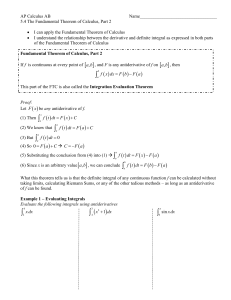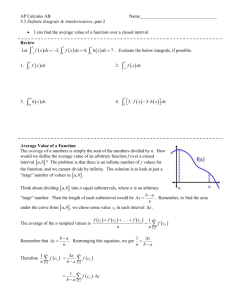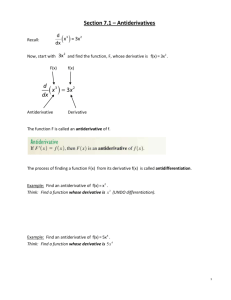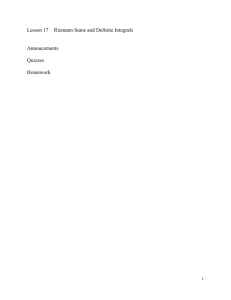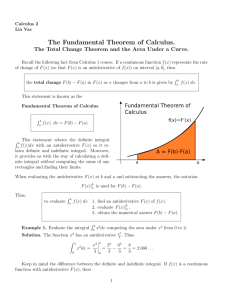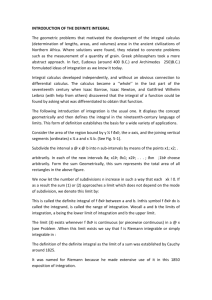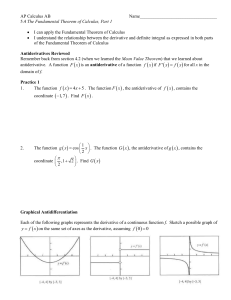SOC 4.3 Notes Bittinger 10th F12
advertisement
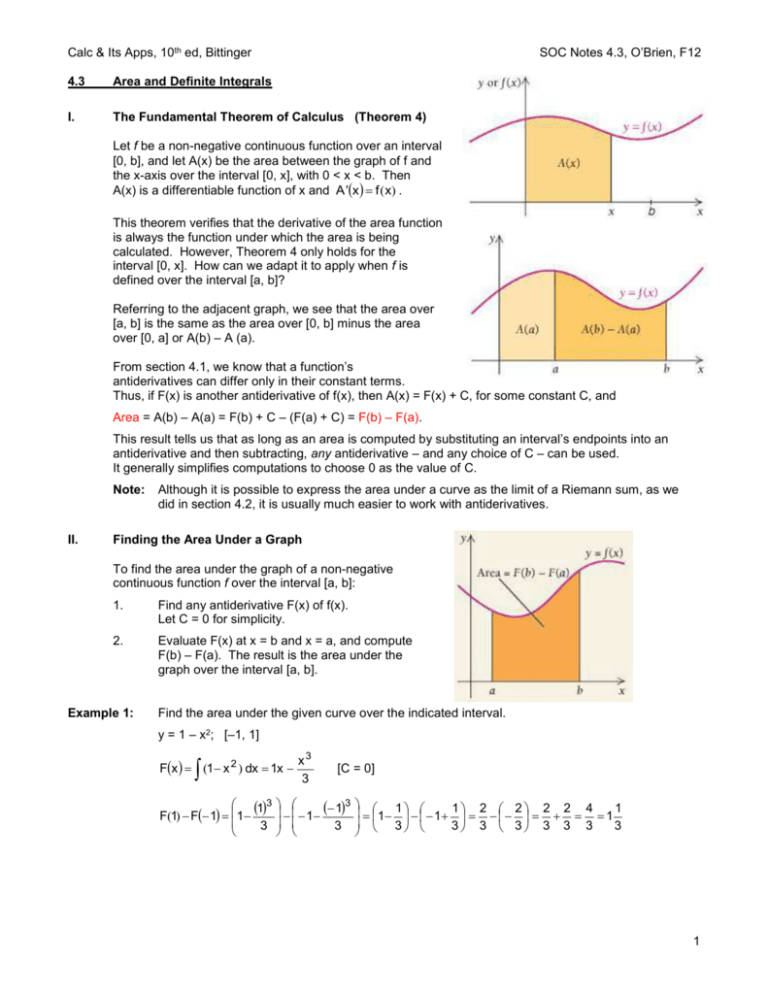
SOC Notes 4.3, O’Brien, F12 Calc & Its Apps, 10th ed, Bittinger 4.3 Area and Definite Integrals I. The Fundamental Theorem of Calculus (Theorem 4) Let f be a non-negative continuous function over an interval [0, b], and let A(x) be the area between the graph of f and the x-axis over the interval [0, x], with 0 < x < b. Then A(x) is a differentiable function of x and A x f (x) . This theorem verifies that the derivative of the area function is always the function under which the area is being calculated. However, Theorem 4 only holds for the interval [0, x]. How can we adapt it to apply when f is defined over the interval [a, b]? Referring to the adjacent graph, we see that the area over [a, b] is the same as the area over [0, b] minus the area over [0, a] or A(b) – A (a). From section 4.1, we know that a function’s antiderivatives can differ only in their constant terms. Thus, if F(x) is another antiderivative of f(x), then A(x) = F(x) + C, for some constant C, and Area = A(b) – A(a) = F(b) + C – (F(a) + C) = F(b) – F(a). This result tells us that as long as an area is computed by substituting an interval’s endpoints into an antiderivative and then subtracting, any antiderivative – and any choice of C – can be used. It generally simplifies computations to choose 0 as the value of C. Note: II. Although it is possible to express the area under a curve as the limit of a Riemann sum, as we did in section 4.2, it is usually much easier to work with antiderivatives. Finding the Area Under a Graph To find the area under the graph of a non-negative continuous function f over the interval [a, b]: 1. Find any antiderivative F(x) of f(x). Let C = 0 for simplicity. 2. Evaluate F(x) at x = b and x = a, and compute F(b) – F(a). The result is the area under the graph over the interval [a, b]. Example 1: Find the area under the given curve over the indicated interval. y = 1 – x2; [–1, 1] Fx (1 x 2 ) dx 1x 13 F(1) F 1 1 3 x3 3 [C = 0] 3 1 1 3 1 1 1 1 2 2 2 2 4 1 1 3 3 3 3 3 3 3 3 1 SOC Notes 4.3, O’Brien, F12 Calc & Its Apps, 10th ed, Bittinger Example 2: Find the area under the graph of the function over the given interval. y = ex, [–2, 3] Fx e x dx e x [C = 0] F3 F 2 e 3 e 2 19.950 III. The Definite Integral A. Definition of the Definite Integral Let f be any continuous function over the interval [a, b] and F be any antiderivative of f. Then the definite integral of f from a to b is b f x dx F(b) F(a) a b It is convenient to use an intermediate notation : f x dx Fx a F(b) F(a) . b a Evaluating definite integrals is called integration. The numbers a and b are known as the limits of integration. Note that this use of the word limit indicates an endpoint, not a value that is being approached, as you learned in Chapter 1. B. Evaluating the Definite Integral By evaluating the definite integral from a to b, we can find the exact area between the x-axis and the graph of the non-negative continuous function y = f(x) over the interval [a, b]. If a function has areas both below and above the x-axis, the definite integral gives the net total area, or the difference between the sum of the areas above the x-axis and the sum of the areas below the x-axis. Example 3: 1. If there is more area above the x-axis than below, the definite integral will be positive. 2. If there is more area below the x-axis than above, the definite integral will be negative. 3. If the areas above and below the x-axis are the same, the definite integral will be 0. Evaluate. Then interpret the results in terms of the area above and/or below the x-axis. x 2 2 x dx 0 2 0 2 x3 x2 x x dx 2 3 0 2 23 2 2 0 3 0 2 3 3 2 2 8 8 6 2 2 3 3 3 3 The area above the x-axis is greater than the area below the x-axis. 2 SOC Notes 4.3, O’Brien, F12 Calc & Its Apps, 10th ed, Bittinger IV. The Fundamental Theorem of Integral Calculus If a continuous function f has an antiderivative F over [a, b], then n lim n b f x i x f x dx F(b) – F(a) i1 a This theorem indicates that we can express the integral of a function either as a limit of a sum or in terms of an antiderivative. 2x 5 Example 4: Evaluate 2 3x 7 dx . 2 5 2 53 3 52 2 23 3 22 2x 3 3 x 2 2x 3x 7 dx 7x 75 7 2 2 2 3 2 3 2 3 2 5 2 250 75 16 485 152 637 35 6 14 2 6 6 3 3 6 V. Applications Involving Definite Integrals To find total profit, total revenue, or total cost, we integrate the corresponding marginal function. Because vt st and at v t st , to find the position function, s(t), we integrate the velocity function, v(t); and to find the velocity function, v(t), we integrate the acceleration function, a(t). Example 5: Accumulated Sales A company estimates that its sales will grow continuously at a rate given by the function S t 20 e t , where St is the rate at which sales are increasing, in dollars per day, on day t. a. Find the accumulated sales for the first 5 days. b. Find the sales from the 2nd day through the 5th day. (This is the integral from 1 to 5.) 5 a. 5 S 20 e t dt 20e t 0 20 e5 20 e0 20 e5 20 (1) $2948 .26 0 5 b. 5 S 20 e t dt 20e t 1 20 e 5 20 e1 $2913 .90 1 3 SOC Notes 4.3, O’Brien, F12 Calc & Its Apps, 10th ed, Bittinger Example 6: Find s(t) given a(t) = –2t + 6, with v(0) = 6 and s(0) = 10. vt at dt 6t C1 t 2 6t C1 2 t 2t 6 dt 2 2 6 02 60 C1 C1 6 vt t 2 6t 6 st vt dt 10 03 3 t 2 6t 6 dt t2 t3 t3 6 6t C 2 3t 2 6t C 2 2 3 3 30 2 60 C 2 10 C 2 s(t) t3 3t 2 6t 10 3 4


